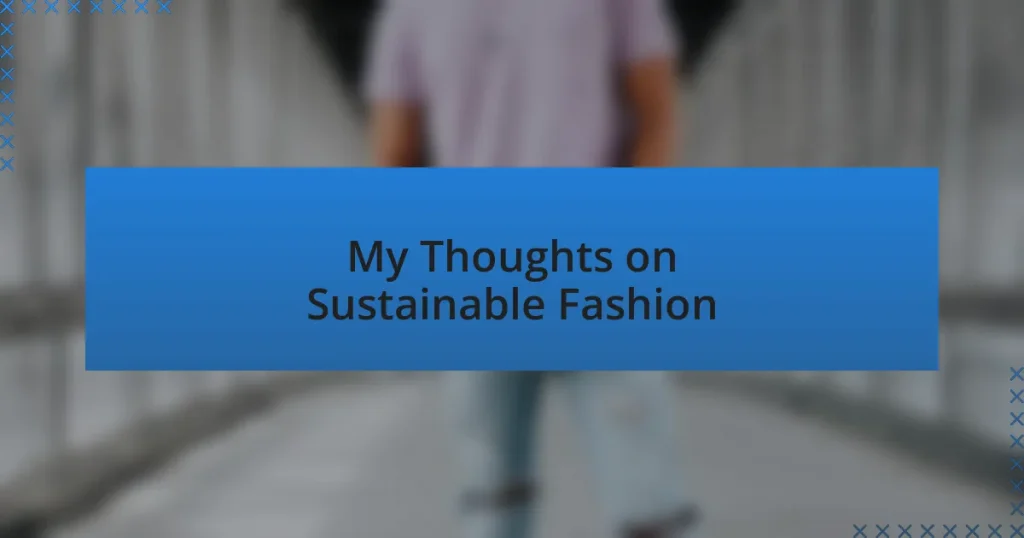Key takeaways:
- Sustainable fashion prioritizes environmental health and social responsibility, encouraging consumers to rethink their clothing choices and support ethical practices.
- Key principles include environmental integrity, social justice, economic fairness, and transparency in the supply chain.
- The shift towards sustainable fashion fosters a lifestyle change, emphasizing quality over quantity and promoting creative recycling ideas.
- Future trends in sustainable fashion include innovations like bio-fabricated materials and a focus on circular fashion, enhancing consumer engagement and responsibility.
Author: Charlotte Hawthorne
Bio: Charlotte Hawthorne is an acclaimed author known for her compelling storytelling and richly drawn characters. With a passion for exploring the complexities of human relationships, her novels often blend elements of romance, intrigue, and self-discovery. A graduate of the University of California, Charlotte has received multiple awards for her work, including the prestigious Silver Quill Award. When she’s not writing, she enjoys hiking in the Sierra Nevada mountains and sipping coffee at local cafes. Charlotte currently resides in San Francisco with her rescue dog, Jasper.
What is Sustainable Fashion
Sustainable fashion refers to an approach to clothing that prioritizes environmental health and social responsibility. I often think about how our fashion choices don’t just affect our wardrobes but also the planet. When I started to learn about sustainable brands, I was surprised by the depth of their commitment to ethical practices, from using organic materials to ensuring fair labor.
This movement encourages us to rethink our consumption habits. Have you ever considered where your clothes actually come from? I remember feeling a mix of guilt and empowerment when I discovered that many conventional apparel factories often exploit workers. Sustainable fashion embraces transparency, urging us to support companies that prioritize ethical labor practices.
In my journey, I’ve found that sustainable fashion isn’t just a trend—it’s a lifestyle change that fosters a genuine connection to the clothes we wear. The more I embraced this mindset, the more I valued quality over quantity. It’s really about creating a wardrobe that tells a story, one that reflects our values and inspires others to think critically about their fashion choices.
Importance of Sustainable Fashion
Sustainable fashion is crucial in combating the environmental crisis we face today. I often find myself reflecting on the staggering amount of waste generated by the fast fashion industry—it’s overwhelming. Just think about how many garments end up in landfills because they were discarded after a single season. This reality fuels my passion for choosing brands that emphasize eco-friendly materials and production methods.
Moreover, embracing sustainable fashion means taking a stand for fair labor practices. When I learned about the challenging conditions many garment workers endure, it hit close to home. I started to ask myself, “Do my fashion choices reflect the values I want to support?” Supporting ethical brands has helped me feel more connected to the story behind each piece I wear, transforming shopping into a conscious act rather than mindless consumption.
It’s not just about personal style; sustainable fashion encourages us to participate in a global movement. The more we advocate for responsible practices, the more we inspire others to do the same. I’ve witnessed conversations spark among friends after sharing the importance of sustainable choices, creating a ripple effect in our communities. Isn’t it empowering to know our fashion decisions can lead to positive changes for the planet and its people?
Principles of Sustainable Fashion
Sustainable fashion is grounded in three key principles: environmental integrity, social justice, and economic fairness. I remember the moment I discovered how sustainable fabrics like organic cotton and hemp can drastically reduce water usage and pesticide exposure. It made me realize that every time I choose a garment made from these materials, I’m not just making a purchase—I’m supporting a healthier planet.
Another essential principle is transparency in the supply chain. Knowing where my clothes come from and how they’re made adds a layer of meaning to my purchases. I still recall the excitement of visiting a local brand that showcased their production process. It was refreshing to see the artisans at work, and it reminded me that behind every piece of clothing, there’s a story that’s worth telling.
Lastly, sustainability promotes longevity in our wardrobes. I’ve shifted my perspective from buying numerous cheap items to investing in high-quality pieces that stand the test of time. This change has not only improved my wardrobe but has also sparked a fulfilling journey of mixing and matching, leading me to discover new styles I never thought I would embrace. How rewarding it is to wear something I know will last and tell a story!
My Sustainable Fashion Choices
When I think about my sustainable fashion choices, one standout piece comes to mind. A few months ago, I stumbled upon a beautifully crafted jacket made of recycled materials at a small thrift store. The thrill of finding unique, second-hand items not only feels like treasure hunting but also reduces waste, and I often wonder how many stories each item carries from its previous life.
I’ve also become more intentional about supporting brands that prioritize sustainability. For instance, I remember my first online purchase from a company that only uses upcycled fabrics. The moment I slipped on that new dress, I felt a sense of pride knowing that I was part of a movement promoting eco-friendly practices. It made me reflect on how our choices can align with our values and change the industry for the better.
As I delve deeper into sustainable fashion, I find myself enjoying the creative aspects of it too. I’ve begun experimenting with DIY projects, like transforming an old pair of jeans into a stylish tote bag. Isn’t it exciting to breathe new life into something that might have been tossed aside? It’s a fun challenge that not only sparks my creativity but also reinforces the idea that fashion can be both stylish and responsible.
Tips for Ethical Shopping
When I shop, I always start by doing my homework on brands before making a purchase. A few months ago, I found myself gazing at a pair of shoes online, and instead of clicking “buy,” I took the time to research the company’s sustainability practices. Discovering that they source their materials sustainably and pay fair wages refreshed my excitement about the purchase, and I felt a connection to a brand that aligns with my values.
I also make it a point to look for certifications when I shop. The first time I spotted a garment with the Global Organic Textile Standard label, I did a little victory dance in my living room. Knowing that my clothes meet strict environmental and social criteria brought a sense of fulfillment I hadn’t felt when buying items without such assurances. It’s liberating to know that there’s a tangible commitment behind my clothing choices.
Shopping second-hand has opened up a whole new world for me. I can’t help but remember the exhilarating moment I stumbled upon a vintage dress that perfectly suited my style and budget. Not only do I get to save money, but I also contribute to extending the lifecycle of clothing, which feels undeniably responsible. Have you ever considered how much history and character each second-hand item holds? That unique charm is something I cherish in my wardrobe.
Future of Sustainable Fashion Trends
Sustainable fashion is evolving at an impressive pace, and I can’t help but get excited about the innovations on the horizon. Recently, I came across a brand experimenting with bio-fabricated materials that mimic leather but are made from mycelium. Imagine wearing a sustainable alternative that is both stylish and kinder to the planet—it felt like a glimpse into a future where our fashion choices have minimal environmental impact.
As I think about the rise of circular fashion, I can almost hear the sigh of relief from my closet. Brands are now encouraging consumers to return used items for recycling or upcycling, sparking a powerful shift in ownership and consumption habits. Have you ever thought about your old clothes having a second life? I love the idea of a dress I once adored being transformed into something completely new, creating fresh stories and memories while minimizing waste.
I also notice a growing emphasis on transparency and storytelling in fashion. When I recently learned about a label that shares the journey of each item they produce, it added an entirely new layer to my shopping experience. This connection reminds me that fashion isn’t just about trends; it’s about respecting the craft and people behind each piece. It really makes me question: how do our clothing choices reflect not just our style but also our values?


